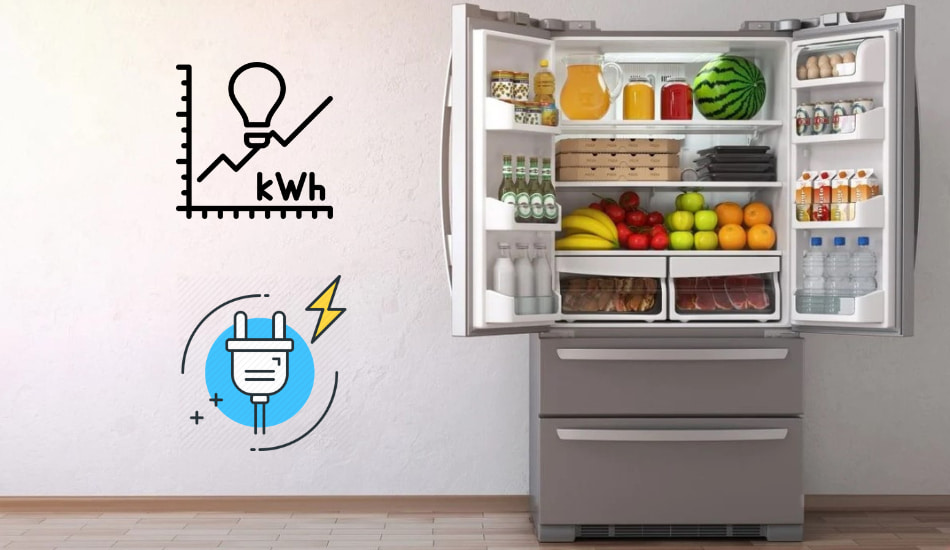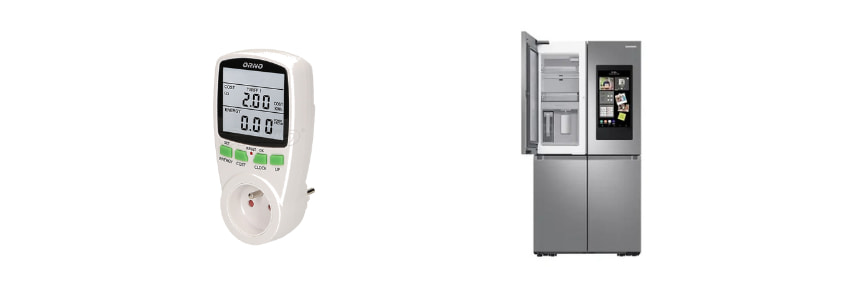Cost Of Running A Refrigerator (10 Tips To Save Power)

We all use fridges in our homes; they’re a constant humming background to our lives, but often, we overlook their power consumption and how much they cost us. Refrigerators generally work 24 hours a day and keep our food fresh.
A standard refrigerator uses approximately 1.4 kWh of electricity daily, up to about 500 kWh annually. But is this a lot of energy? In this article, we’ll delve deeper into the power usage of refrigerators and talk about how much it costs to run a fridge. So, let’s start!
How Much Electricity Does My Refrigerator Use? Typically, a refrigerator use between 300 and 800 watts per day, drawing approximately 3 to 6 amps and around 120 volts of electricity. This means that a fridge consumes around 1.4 kWh per day, costing us around $7 to $10 per month to run it (23 cents per kWh is the average price in the United States).
Due to different factors like the fridge’s age, model, size, and set temperature, this figure isn’t consistent across all refrigerators. Although some households have more than one refrigerator, they are consumers of electrical energy that we cannot ignore because they affect our bills.
It is also necessary to keep in mind that they work 24/7 throughout the year. Below we will go through this topic in more detail.
How Much Electricity Does a Refrigerator Use?

A standard refrigerator typically uses around 1.4 kWh of electricity daily or around 43 kWh monthly. This amounts to nearly 500 kWh per year. Using the average electricity rate of 23 cents per kWh in the United States, running a fridge monthly will cost around $10 (depending on your model).
The energy usage of a residential fridge usually ranges from 300 to 800 watts, equivalent to 3 to 6 amps and around 120 volts. However, fridges ‘operational’ wattage is typically less than their specified average wattage because they cycle on and off all day.
As a simple guide, you can estimate the actual energy consumption by dividing the fridge’s wattage by 3. Therefore, a fridge rated at 500 watts will likely use approximately 167 running watts.
The electricity usage and bills are expressed in kilowatt-hours (kWh), a unit that indicates energy use over a specific period of time. A single kilowatt (kW) equals 1,000 Watts (W), implying that running an average refrigerator daily would consume roughly 1.4 kWh of electricity.
Related Article: How Much Power (Watts) Does An AC Use?
Cost Of Running a Frdige In The U.S.

Using the standard power ratings of the refrigerators discussed earlier and the average electricity cost per kWh in the United States (U.S.), which is 23 cents, we can effortlessly calculate the daily, monthly, and annual operating expenses. Here are the results:
| Type of Fridge | Power (kWh) | Daily Cost | Monthly Cost | Annual Cost |
|---|---|---|---|---|
| Normal Refrigerator | 500 | $0.21 | $5.73 | $72 |
| Eco-cost Refrigerator | 250 | $0.11 | $2.91 | $30 |
| Mini Refrigerator | 200 | $0.08 | $2.45 | $29 |
| Large (old) Refrigerator | 1,800 | $0.77 | $17.92 | $231 |
As you can see, running a refrigerator is not so costly, however, over the years of use, consumption increases. Operating an older, larger refrigerator is approximately four times costlier than running a fairly newer model. Moreover, you can save even more energy if you opt for refrigerators with ENERGY STAR certification.
Related Article: Where to Put the Microwave in a Small Kitchen?
Cost Of Running a Frdige In The U.K.
Once more, we’ll use the standard power specifications of the refrigerators we’ve discussed before. Also, we’ll use the average cost per kWh for the UK (22p) to calculate the daily, monthly, and annual operating expenses. Here are the results:
| Type of Fridge | Power (kWh) | Daily Cost | Monthly Cost | Annual Cost |
|---|---|---|---|---|
| Normal Refrigerator | 500 | £0.27 | £7.19 | £89 |
| Eco-cost Refrigerator | 250 | £0.14 | £3.68 | £43 |
| Mini Refrigerator | 200 | £0.11 | £3.45 | £41 |
| Large (old) Refrigerator | 1,800 | £0.87 | £22.32 | £291 |
As we can see, the price in the UK is different when it comes to running a refrigerator – the costs are significantly higher compared to the US. On the bright side, the consumption figures mentioned earlier are average estimates, which means more contemporary, energy-efficient devices will have lower operating costs.
Calculate Accurate Power Consumption Of Refrigerator

By using a Kill A Watt meter, you can easily measure the power consumption of any electrical device in your house, including a refrigerator. If you don’t have one already, you can order it on Amazon at a very affordable price.
How to use a Kill A Watt meter?
The process is pretty simple. First, plug your device (kill a watt meter) into an electrical outlet, and connect your refrigerator plug into it. Turn on the Kill a Wat meter and start using your refrigerator. After you’re done, check how much electricity (kWh) was used on the device. It will show you the exact power that your refrigerator uses. Some models will also display the price in dollars.
If you are still not sure how to use this device, then check this youtube video:
10 Ways To Lower the Cost of Running A Refrigerator
Now that we know how much electricity the refrigerator consumes and how much it amounts to on your bill, we will present you with 10 ways to reduce that consumption to a certain limit.
- Keep the Top of the Fridge Empty. The fridge’s top is often used as a makeshift shelf, cluttered with items like cereal boxes, games, and fruits. While it may seem convenient, it’s advisable to avoid piling things atop your fridge and to maintain at least a few inches of free space around it.
- Avoid Heat Sources. When refrigerators are close to heat-emitting appliances, they need to consume more energy, which means higher bills. So, keep your fridge away from appliances like ovens, microwaves, and heaters.
- Keep the cooling temperature constant. Find the appropriate temperature at which you will keep your food in the fridge and do not change it. Overcooling is unnecessary and results in a waste of money and energy.
- Avoid placing hot food in a fridge. Allow your food to cool down before storing it in the fridge to prevent it from having to work harder. Storing hot food raises the fridge’s interior temperature, causing it to use more power to cool down. Letting your food cool at room temperature before storing it can prevent an increase in operating costs.
- Avoid unnecessary door openings. We’ve all had moments where we repeatedly and absentmindedly open the fridge, hoping for some new items to have magically appeared. Each time you open the door, warm air seeps in, and the refrigerator has to consume more energy to return to its preset temperature.
- Regularly Check your fridge’s door seals. Over time, the wear and tear on fridge door seals can lead to cracks and reduced efficiency, allowing the cool air inside to leak out. This results in your fridge consuming more power to maintain its internal temperature. Regular checks can ensure the seal is in good condition and not letting cool air escape.
- Maintain clean refrigerator coils. The coils located at the back of the fridge are responsible for dispelling heat. Any dirt accumulation on these coils can hinder their heat transfer capacity. Such build-up reduces your fridge’s performance efficiency, increasing operational costs.
- Only power what’s necessary. When considering an upgrade, choose a refrigerator size that suits your needs. Avoid spending on oversized refrigerators or separate fridges and freezers that remain half-empty. Downsizing your refrigerator can help decrease your operating costs.
- Utilize Energy-Saving Modes. If your refrigerator has an energy-saving or eco-mode feature, make sure to use it. These modes are designed to maximize the fridge’s efficiency and minimize power consumption, thus saving you money over time.
- Regularly Defrost the Freezer. If your fridge has a manual defrost freezer, ensure that you defrost it regularly. A build-up of ice can make your appliance work harder and consume more electricity, leading to increased costs. Regularly defrosting your freezer ensures it operates at peak efficiency and doesn’t consume more energy than necessary.
Related Article: Can Refrigerators Share An Outlet? (Explained)
FAQ: People Also Ask
How much does it cost to run a fridge for the day?
The cost to run a fridge for a day depends on its energy consumption and your local electricity rates. On average, a standard fridge consuming about 1.4kWh per day at a rate of 23 cents per kWh (a common rate in the U.S.) would cost approximately 29 cents per day.
Does a running refrigerator use a lot of electricity?
According to Reduction Revolution, a typical refrigerator will consume around 1 to 2 kilowatts per hour daily. This is equal to an approximate annual cost of $150.
Is it cheaper to run a full fridge?
The best way is to fill your fridge with about three-quarters loaded with food. This provides enough room for air to move around inside freely, and concurrently, ample food assists in maintaining the coolness of adjacent items.
Final thoughts
In conclusion, while refrigerators are essential household appliances, their continuous operation contributes to our electricity bills. However, with understanding and good habits, these costs can be reduced. On the other hand, running a refrigerator is not so costly.
Key factors that are important are the age, type, and size of the fridge, its temperature settings, and how fully it’s stocked. Remember that investing in a modern, energy-efficient model is worthwhile, and keeping it three-quarters full for optimum operation. Ultimately, small changes can lead to meaningful savings over time for your wallet and the environment.

